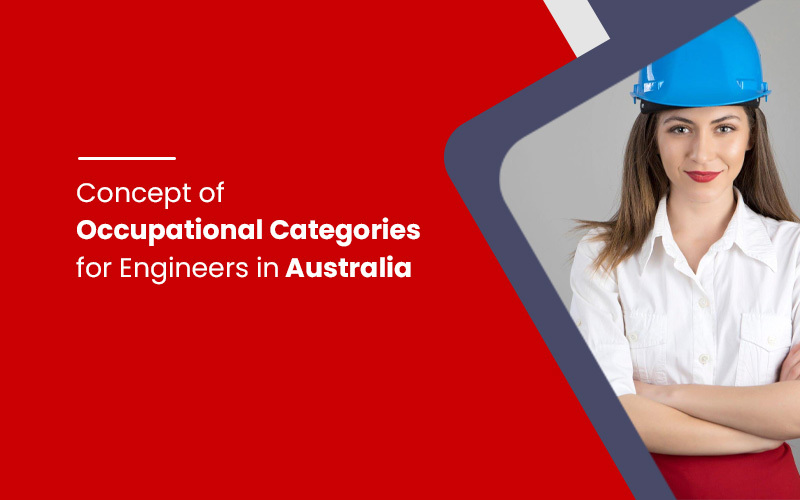Concept of Occupational Categories for Engineers in Australia

Table of Contents
- Overview of Occupational Categories for Engineers in Australia
- Exploring different engineering specializations in Australia
- Importance of occupational categorization for engineers
- Career opportunities within occupational categories
- Engineers Australia and its role in recognizing occupational categories
- Advantages of being categorized as an engineer in Australia
- Steps to qualify for occupational categories in engineering
- Growth and professional development within occupational categories
- Exploring the most in-demand engineering careers in Australia
- Conclusion
Engineers Australia is the main body responsible for all the procedures related to the skilled migration of Engineers to Australia. In addition, Engineers Australia is the designated assessing authority for various occupations in the engineering sector. Engineers Australia has recognized mainly three occupational categories within the engineering practice of Australia.
When pursuing a career in engineering, understanding the occupational categories is essential for professional growth and recognition in Australia. This comprehensive guide will explore the various occupational categories recognized by Engineers Australia and provide valuable insights to help engineers get a positive skills assessment.
Overview of Occupational Categories for Engineers in Australia
In Australia, engineers are classified into specific occupational categories based on their areas of expertise and specialization. Understanding these categories helps engineers showcase their skills and qualifications accurately.
The standard classification of occupations recognized by Engineers Australia includes the following:
- Professional Engineer
- Engineering Technologist
- Engineering Associate
- Engineering Manager
1. Professional Engineer
Overview:
- Priority is given to the overall system.
- Pursues engineering possibilities sustainably, considering environmental, community, and social concerns.
- Uses structured methods to conduct and manage engineering projects
- Makes use of systematic engineering synthesis and design processes
- Applying known engineering approaches to complex issues.
- Demonstrates professionalism in the field of occupation
A professional engineer must have the academic qualification of a four-year Australian bachelor’s degree in engineering from a university after completing 12 years of schooling or equivalent.
The Professional Engineer is in charge of the overall system and engineering tasks. Therefore, they must have leadership skills since they will deal with clients and understand clients’ needs, a wide range of stakeholders, and society.
While engineering produces tangible outcomes, the activity of Professional Engineers is primarily cerebral. Professional engineers are responsible for solving difficulties, finding quick solutions to problems and challenges that emerge, and managing risk and sustainability issues. They must guarantee that technical and non-technical concerns are integrated.
Professional Engineers are primarily concerned with the development of new technologies and the enhancement of existing ones. They should use new and creative ideas in their work.
Professional Engineers may be involved in engineering studies, data collection, and the development of new methods and applications within a broad engineering discipline.
2. Engineering Technologist
Overview
- Focuses on the system’s interactions
- Uses well-established engineering methodologies, techniques, tools, and resources within the technological area.
- Engineering technology advances
An Engineering Technologist should have an academic qualification of three years of an Australian bachelor’s degree in engineering; completing 12 years of education or equivalent is required for
They are experts in the sector related to the theory and practice of a particular field of engineering technology and its application, adaptation, or management in various settings, as the name implies. Engineering technologists are mostly expected to focus on system interfaces. However, they often operate in broad-defined technical contexts, accepting various tasks and responsibilities as they modify and adapt existing engineering processes.
There is a significant distinction between Engineering Technologists and Professional Engineers. Engineering Technologists do not have the same broad duties as Professional Engineers. However, Engineering Technologists must have a solid knowledge of practical issues and applications and the intellectual challenge of staying up to speed on cutting-edge trends as an expert in a technical sector and how they connect to existing practice.
Read More: Statutory Declarations and Affidavits for ACS Skill Assessment. 🔥🔥
3. Engineering Associate
Overview
- Focuses on particular system aspects
- Observes codes and follow existing norms and procedures
- Acquire technical assistance in the research, design, manufacturing, assembly, building, operation, and maintenance of machines and equipment, facilities, distribution systems, and installations.
- Aids in the estimate of resources and the examination of the site
- Drawings, plans, diagrams, designs, maps, and charts are prepared, interpreted, inspected, and revised.
The academic qualification required for Engineering Associate is a two-year Australian Diploma or Associate Degree in Engineering after 12 years of education or equivalent.
Engineering Associates should be able to concentrate on a single aspect of the system. Therefore, they perform a variety of roles within engineering businesses and teams. Their primary responsibilities include feasibility study, scoping, defining criteria/performance measurements, evaluating and reporting technical and procedural choices, quality assurance, costing, budget management, document control, quality assurance, etc.
Engineering Associates must be familiar with standards and norms of practice and be experts in their interpretation and application to various circumstances. Professional engineers and Engineering Technologists may be more knowledgeable with extensive elements of plant and equipment that can contribute to safety, cost, or effectiveness in operation.
Engineering Associates may have extensive design and development procedures knowledge in other situations. In Australia, the word “paraprofessional” is commonly used to denote the Engineering Associate vocation.
Learn More: How ACS work experience deduction calculation is done? 💪💪
4. Engineering Manager
Overview
- Develops engineering strategies, policies, and plans for their implementation.
- Engineer operations are administered and reviewed for the firm.
The academic prerequisite for Engineering Manager is a bachelor’s degree or higher in engineering or a related subject after 12 years of schooling or equivalent.
The Engineering Manager is also recognized as a supplementary category for migration purposes. The engineering manager is not an engineering occupation but a member of the Managers ANZSCO group.
The Engineering Manager examines engineering operations and can develop engineering strategies, policies, and plans. They have a high-level executive role that entails developing engineering strategies, policies, and plans and directing, administering, and overseeing an organization’s engineering activities.
They are responsible for developing, executing, and monitoring engineering strategies, policies, and plans and providing engineering technique guidance. They also monitor performance and verify that engineering requirements of quality, cost, safety, and timeliness are met.
Engineering Managers help to study and organize engineering projects. They oversee staff selection, training, development, planning, organizing, directing, managing, and coordinating the organization’s engineering and technical activities.

Exploring different engineering specializations in Australia
Engineers can choose from various specializations within the occupational categories based on their interests and career goals. Some popular engineering specializations in Australia include civil, mechanical, electrical, and chemical engineering. By selecting a specialization, engineers can focus their expertise and enhance their career prospects within their chosen ANZSCO codes.
Importance of occupational categorization for engineers
The categorization of engineers into occupational categories holds significant importance. It provides a standardized framework for assessing and comparing engineering qualifications and expertise. Occupational categorization ensures that engineers meet the required standards and possess the necessary skills to undertake engineering roles in Australia.
Career opportunities within occupational categories
Each occupational category presents unique career opportunities for engineers. Professional Engineers often take on leadership and decision-making roles in complex engineering projects. Engineering Technologists provide technical support and play a vital role in project management.
Engineering Associates collaborate closely with engineers and technologists to implement and maintain engineering projects. Engineering Managers oversee project planning, coordination, and team management.
Engineers Australia and its role in recognizing occupational categories
Engineers Australia, the professional body representing engineers in Australia, is crucial in recognizing and defining occupational categories. They set the standards and guidelines for engineering qualifications and provide pathways for engineers to attain professional recognition within their chosen ANZSCO category.
Advantages of being categorized as an engineer in Australia
Being categorized in one of the occupational categories by Engineers Australia offers several advantages. It provides a clear professional identity, enhances employability, and improves credibility within the engineering industry. It also opens doors to various networking and career development opportunities.
Steps to qualify for occupational categories in engineering
To qualify for different occupational categories, engineers need to meet the requirements of Engineers Australia. These requirements may include academic qualifications, professional experience, Competency Demonstration Reports (CDRs), and interviews. Engineers can refer to the Engineers Australia website for detailed information on the qualification process for each category.
Growth and professional development within occupational categories
Numerous growth and professional development opportunities exist once engineers are categorized into their respective occupational categories. Engineers can undertake additional certifications, participate in industry events, join professional networks, and continuously learn to enhance their skills and stay up-to-date with advancements in their field.
Exploring the most in-demand engineering careers in Australia
Due to infrastructure development and technological advancements, certain engineering occupations are in high demand in Australia. Some of the most sought-after engineering careers include civil engineering project managers, mechanical design engineers, electrical power engineers, and software engineers. Engineers can choose their occupational category, ANZSCO codes, and specialization based on these in-demand careers.
Conclusion
Understanding the occupational categories for engineers in Australia is crucial for professional success in engineering. By aligning their expertise with the recognized categories, engineers can maximize their career opportunities and contribute effectively to engineering.
If you have any questions about occupational categories or other CDR writing methods, please get in touch with us, and we will assign you to our best consultant to assist you. CDR Writers Australia is an Australian-registered consultant that offers RPL report writing, KA02, CDR report tutoring, and reviewing services.
Recent Posts
- Stage 1 Competency Standard for Professional Engineer December 4, 2023
- Secure Your Future: The Most In Demand Jobs for Skilled Migrants to Australia in 2024 November 3, 2023
- Engineers Australia Fees For Skills Assessment October 2, 2023
- A Comprehensive Guide to Australia Partner Visas: Requirements, Process, and Tips August 31, 2023
- Unlocking Your Dreams: Ultimate Guide to Australian PR Pathways August 11, 2023






